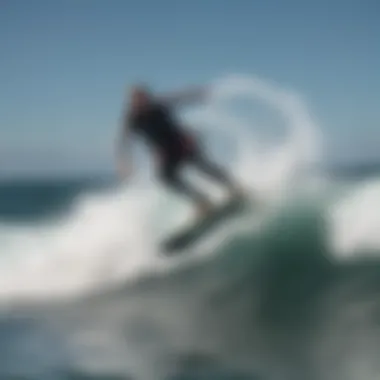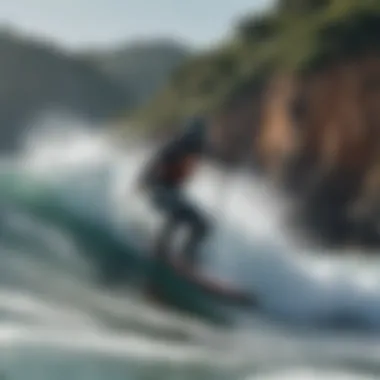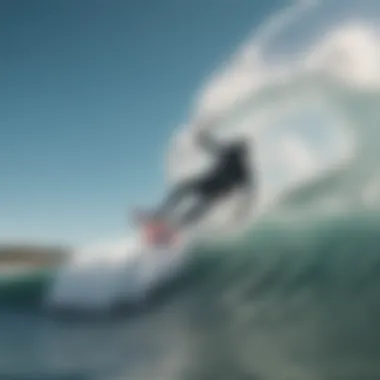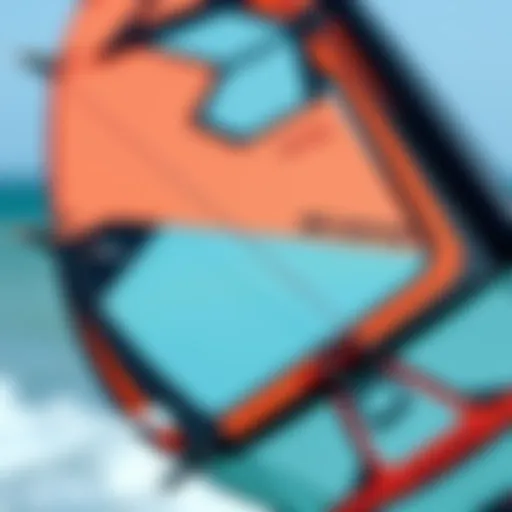Navigating Waves: A Kiteboarder's Guide to Mapping


Intro
Kiteboarding is not just a thrilling sport; it's a dance with nature. Understanding the waves and how they interact with your kite adds layers of opportunity and skill to the experience. But let's face it, mastering the ocean isn't as simple as just launching your kite and hoping for the best.
Every swell, every ripple tells a story about the wind and water, and as a kiteboarder, you'll want to be in tune with those stories if you aim to navigate effectively and enhance your ride. It's crucial to grasp how wave patterns can change under various conditions and to use that knowledge to your advantage.
This article explores those complexities and introduces the innovative maneuvers and techniques you can employ.
What lies ahead is a conversation about equipment that suits both novices and seasoned riders, insights into advanced techniques that can elevate your skills, and safety practices crucial for your time on the water.
After all, the better understanding you have of waves and their navigation, the more confident your rides will feel.
Gear Insights
When it comes to kiteboarding, the right gear can make all the difference. Knowing what you need helps navigate those waves like a pro.
Latest Gear Reviews
In the world of kiteboarding, technology evolves quickly. Here are some recent gear that’s turning heads:
- Ozone Edge V10: Known for its excellent range and stability. Perfect for those gusty days out on the water.
- Naish Pivot 2023: A versatile kite balancing stability and performance, great for jumping and freeriding.
- Duotone Neo: The design provides fantastic lift and easy relaunch, ideal for all levels but especially for those still learning the ropes.
These brands consistently showcase innovation, offering kiteboarders the tools to navigate varying wave dynamics.
Essential Gear for Beginners
For those just taking their first steps into kiteboarding, the selection seems overwhelming. However, focusing on the right essentials can set you up for success:
- Kite: Choose a user-friendly model. Something like the Ozone Buzz provides ample safety features.
- Harness: Look for a comfortable, adjustable harness like the Mystic Warrior, which distributes load effectively.
- Board: A larger board, such as the Naish Motion, offers better stability for beginners.
- Safety Gear: Don’t forget a good helmet and impact vest; safety first is not just a saying, it’s a necessity.
Selecting these key items will ease newcomers into the intricacies of wave dynamics.
Techniques and Tips
Having quality gear is one aspect; what you do with it is another. In kiteboarding, techniques play a significant role in how you interact with waves.
Advanced Tricks and Techniques
For those who’ve got a handle on the basics, pushing your limits can be exhilarating. Consider these advanced maneuvers:
- Downlooping: Initiating a downloop while jumping can give another level of lift. However, execute cautiously.
- Kiteloops: This trick is eye-catching but complicated. Try them with proper wind and enough space.
- Wave Riding: Tuning your kite and body movements to sync with wave patterns creates a smooth ride.
With each trick, always maintain awareness of your environment.
Safety Practices for Kiteboarders
Safety cannot be neglected despite the urge to chase those exhilarating rides. Here are crucial tips:
- Kite Control: Always position your kite at 12 o'clock when not riding to prevent mishaps.
- Wind Awareness: Know how wind direction and strength affect waves. Align your takeoff with the current.
- Emergency Protocols: Practice releasing your kite quickly and make sure you have a safety leash.
As you navigate these techniques, remember that understanding the waves is a continuous journey.
Prelims to Wave Dynamics
Understanding the dynamics of waves is crucial for kiteboarders, whether you are just starting or have years of experience under your belt. Waves impact not just how a kiteboarder rides but also their overall safety and enjoyment while navigating the waters. Grasping the interplay between waves and kiteboarding can significantly enhance performance and decision-making, allowing riders to harness the ocean's energy rather than merely enduring it.
What makes waves so intriguing is their nature—being fluid, ever-changing, yet following certain predictable patterns. The topography of the sea bed, wind speed, and current contribute to the unique characteristics of waves any kiteboarder faces.
The understanding of wave dynamics goes beyond simply observing the surface; it also includes recognizing the currents and swells, appreciating how these elements can vary from one spot to another, and how they may change throughout the day. Kiteboarding isn't just about you and the kite; it’s about engaging in a dialogue with the ocean itself.
The Nature of Waves
Waves can be described as the energy traveling through water caused by factors such as wind and geological events. Simply put, they are ripples that convey energy from one part of the ocean to another. They can be further observed in two primary forms—surface waves and internal waves. Surface waves are what kiteboarders see most often, riding the peaks and troughs that are visible at the water's surface. Understanding how these waves form is key to better navigation and riding techniques.
Types of Waves Impacting Kiteboarding
The wave's influence on kiteboarding primarily comes from three types: Wind waves, Swells, and Groundswells. Each type presents its own set of characteristics and demands different approaches for riding effectively.
Wind waves
Wind waves are typically formed by local winds. Their key characteristic is that they can change rapidly; one minute you might have a soft chop, and the next, strong gusts could create a completely different riding environment. This variability is both a challenge and an opportunity for kiteboarders. They often provide excellent conditions for beginners to learn, as they can be predictable in certain wind conditions. However, the disjointedness of wind waves can make them a tricky prospect for advanced maneuvers, requiring keen reflexes and adaptability.


Advantages include more accessible locations like beaches exposed directly to winds. On the downside, wind waves can also lead to very choppy conditions which might feel a bit overwhelming for less experienced riders.
Swells
Swells, or the waves that have traveled long distances from their point of generation, present a different characteristic. They tend to have a smooth, rolling pattern. Swells provide a fantastic riding experience for those who know how to engage with them since they can often deliver a more prolonged ride.
The unique feature of swells is their consistency—once they form, they often maintain their shape and strength over larger distances. This predictability allows kiteboarders to plan their rides effectively. However, swell conditions can also introduce larger waves that may be daunting to some, especially those still finding their feet in the sport.
Groundswells
Groundswells are formed by distant storms and can travel huge distances without losing their strength. Their key characteristic? Strength and height. Groundswells can create some of the most exhilarating riding experiences, offering big waves and powerful rides.
The unique feature of groundswells is that they can provide a more consistent left and right breaking wave, favoring different riding directions. However, with great power comes great responsibility; these can quickly exceed what a novice kiteboarder is prepared for, which is why familiarity and respect for these waves’ characteristics is essential.
The Importance of Wave Mapping
Understanding waves and their patterns is crucial for kiteboarders aiming to enhance their performance and experience on the water. Wave mapping is not merely a techy fancy; it’s an integral part of mastering kiteboarding. Knowing how to read the waves allows kiteboarders to optimize their routes, predict changes in sea conditions, and ultimately improve their safety on the water.
The art of wave mapping involves identifying various wave types and the currents that shape them. Kiteboarders who neglect this knowledge may find themselves in tricky spots, unable to exploit the ocean’s energy properly.
Understanding Currents and Their Effects
Currents are like the unseen forces that play a pivotal role in wave mapping. They can dramatically influence wave formation and intensity. For instance, a fast-flowing current can create choppy conditions, making it harder to control the kite. Conversely, a favorable current can work wonders, allowing riders to harness more power and achieve those thrilling jumps or smooth rides.
Key Considerations in Understanding Currents:
- Documentation: Keeping records of local currents at different times of the year helps predict future conditions.
- Weather Patterns: Changes in wind can also cause shifts in current directions. A south wind might enhance north currents, affecting how waves break and roll.
Navigating these currents enhances a kiteboarder’s strategic planning. For example, if a rider is aware of a strong offshore current, they might choose a landing spot that's a bit closer to shore to avoid tiring themselves out while returning.
Navigating Kiteboarding Spots
Nailing down how to analyze wave maps redefines the kiteboarding experience. A good kiteboarder doesn’t just wing it when they hit the water; they come equipped with knowledge about the spots they’re targeting. When mapping out potential kiteboarding locations, it’s vital to consider various factors:
- Local Knowledge: Engaging with local kiteboarding communities can provide invaluable insights. Sometimes a simple chat at the beach can reveal the nuances of a spot that maps can't convey.
- Previous Data: Leveraging historical wave and wind data is another way of ensuring a safer and more effective ride. Websites that aggregate such information can be a treasure trove of insights.
- Visual Inspection: Upon arriving at a spot, kiteboarders should conduct visual observation. From spotting the entry and exit points to identifying where waves are breaking, this firsthand assessment allows for on-the-spot adjustments to riding techniques.
"The ocean is constantly changing, and so are the waves; being attuned to those shifts can mean the difference between a mediocre ride and an epic session."
By grasping the importance of wave mapping, kiteboarders can navigate their favourite spots more effectively and enjoy their time on the water. This understanding can also lead to more sustainable practices, ensuring that these beautiful environments are preserved for future adventures.
Key Techniques for Mapping Waves
A thorough grasp of the techniques for mapping waves is vital for kiteboarders. Knowing how to read wave patterns can mean the difference between a thrilling ride and a treacherous situation. These techniques offer a roadmap of sorts, guiding kiteboarders through varying conditions, allowing them to harness wave energy effectively. The importance lies not just in enhancing performance but also in ensuring the safety and enjoyment of the sport.
Let's dive deeper into these critical methods for wave mapping.
Visual Observation Skills
The art of keen observation can’t be overstated. Kiteboarders who take the time to study their surroundings can glean crucial insights about the waves. Observe the horizon; notice the shapes and movements of waves as they approach the shore. Pay attention to how waves interact with each other and their environments.
- Look for patterns: Repeated behaviors can indicate where the strongest or weakest currents are, guiding kiteboarders on where to ride.
- Assessing weather changes: Variations in wind or light conditions can affect wave behavior, so being aware of these factors can enhance understanding.
- Recognizing local characteristics: Each kiteboarding spot has its unique wave pattern influenced by underwater topography, current systems, and wind conditions. Grasping these can lead to a more successful session.
Successful kiteboarders don’t just ride the waves; they anticipate them. This ability can significantly enhance both performance and safety.
Utilizing Software Tools
In today’s digital age, technology plays a central role in enhancing the way kiteboarders map waves. Various software tools offer real-time data, forecasts, and analytics that are instrumental for every level of kiteboarding enthusiast.
Mobile applications
Mobile applications have become a preferred choice for many kiteboarders due to their convenience. Programs like Windy, Kite Mapper, and MyRadar provide up-to-the-minute weather information and wave check. These apps are often optimized for easy navigation, allowing users to quickly interpret data.
Key characteristics:
- Portability: Easy access while on the go, which works perfect when visiting new spots.
- Real-time updates: Users receive immediate information about conditions, which is especially crucial for windy or rapidly changing situations.
A unique feature often found in these apps is their interactive mapping, where users can visualize current conditions on a map. The primary advantage is that it combines local knowledge with high-tech data, but users should be wary of occasional inaccuracies in forecasts due to ever-changing weather patterns.
Web-based platforms
Web-based platforms also offer significant advantages for mapping wave conditions. Tools like Magicseaweed and Surfline provide comprehensive surf forecasts, including extensive datasets on wave height, frequency, and swell direction. Such detailed insights are invaluable for kiteboarders looking to plan their sessions.


Key characteristics:
- Detailed analytics: In-depth data allows for a clearer understanding of conditions well before heading out.
- Community interactions: Many platforms offer forums where kiteboarders can share experiences and tips, fostering a rich community of information.
The unique feature here is often the integration of user-generated reports and real-time footage from select locations. The downside might be the dependency on internet connectivity, but with adequate planning, web tools can greatly amplify a kiteboarder's ability to predict and ride waves more effectively.
To navigate wave conditions well, kiteboarders must blend traditional skills with modern technology. Mastering these techniques will lead to a deeper understanding of the ocean's rhythms.
Advanced Wave Mapping Technologies
Understanding wave mapping necessitates an appreciation for the advanced technologies utilized in the process. These tools not only enhance the precision of wave mapping but also empower kiteboarders to navigate through various conditions with greater confidence. When kiteboarders are well-versed in these tools, they can better predict wave behavior and adjust their techniques accordingly. Let's delve into some key technologies that make wave mapping not just efficient but transformative for the sport.
Satellite Imagery
Satellite imagery has emerged as a powerful resource in wave mapping. By capturing vast swathes of the ocean from above, satellite systems like those operated by NASA unlock information about wave heights, patterns, and movements. These images serve as a visual guide, helping kiteboarders anticipate changes in the ocean’s surface.
One significant advantage is the ability to observe areas that are otherwise difficult to access. For instance, a kiteboarder preparing for a session in a more remote region can utilize satellite images to assess wave conditions ahead of time. This foresight can mean the difference between an exhilarating experience and a challenging session. Moreover, with recent advancements, the resolution of satellite images is improving, offering increasingly detailed insight into specific locations.
Buoys and Sensor Technologies
Buoys equipped with sensor technologies have become a staple for gathering real-time data on wave conditions. These floating beacons measure wave height, direction, and even water temperature, sending this information back to shore-based systems. For kiteboarders, this data is invaluable.
- Immediate Updates: Kiteboarders can receive immediate updates about wave conditions along their chosen route.
- Predictive Analyses: As this data is collected over time, it allows for predictive analyses that can inform kiteboarders about what waves to expect based on past conditions.
- Safety Mechanism: More advanced bouys also track rip currents and other hazards, providing notifications for users which contribute to safer kiteboarding experiences.
In short, these technologies act like a weather report tailored specifically for kiteboarders, keeping them informed and ready.
Remote Sensing Techniques
Remote sensing stands as a pivotal innovation for wave mapping. Utilizing various technologies such as radar and LiDAR, remote sensing captures information about wave characteristics from great distances. These methods can even operate regardless of weather conditions or light availability.
- How It Works: By sending out waves that bounce back after hitting the surface of the water, these systems can capture detailed information on wave profiles.
- Spatial Coverage: Remote sensing can cover extensive geographic areas, thus furnishing kiteboarders with a comprehensive picture of conditions across different spots.
- Data Integration: The data collected can be integrated into modeling systems that predict wave behavior over time, immensely aiding planning for kiteboarding activities.
Ultimately, remote sensing serves to fill gaps left by traditional observational techniques, allowing for precise mapping of wave dynamics that can lead to enhanced performance on the water.
The evolution of wave mapping technologies is transforming the kiteboarding landscape, providing insights that can significantly enhance both performance and safety.
Analyzing Wave Patterns
Understanding wave patterns is crucial for kiteboarders, as they dictate not only the quality of the ride but also the safety measures that need to be taken. Waves are like the ocean's fingerprint; each one is different, shaped by the wind, the ocean floor, and the weather. Analyzing these patterns allows riders to anticipate changes and adapt their techniques accordingly, ensuring a more enjoyable and safer experience.
Wave Frequency and Amplitude
Wave frequency refers to the number of waves that pass a specific point in a given timeframe. While amplitude signifies the height of the waves. Together, they create a dynamic landscape for kiteboarders. Here's why understanding these two elements matters:
- Riding Techniques: The frequency can signal when to execute maneuvers. A higher frequency may mean shorter rides, while lower frequency could allow for longer, smooth transitions.
- Physical Limits: Amplitude directly impacts the physical strain on a rider. Waves with greater amplitude can be more challenging to navigate, potentially leading to falls or equipment damage if one isn’t prepared.
- Energy Transfer: The relationship between frequency and amplitude can assist riders in predicting the energy transfer from the wave to their kite. A tall, less frequent wave provides a different riding experience compared to shorter, rapid waves.
In analyzing wave frequency and amplitude, kiteboarders can better assess the conditions and adjust their strategies, gear, and techniques accordingly.
Impact of Wind Conditions
Wind conditions play a significant role in shaping both frequency and amplitude, thereby influencing wave patterns directly. The wind’s speed and direction can make a calm sea turn into a tumultuous body of water in no time. Here’s how kiteboarders should consider wind conditions:
- Wind Speed: A strong wind can elevate wave frequency and amplitude. For example, a gusty day could lead to sharp, high waves that might catch a beginner off guard.
- Wind Direction: Coming from the shore versus offshore can create entirely different wave types. Onshore winds often lead to disorganized, choppy waves, while offshore winds facilitate smoother, more organized conditions, ideal for interesting maneuvers.
- Wave Patterns React: According to the wind’s behavior, the waves will not only change in height, but their breaking pattern can shift as well, from a gradual slope to sudden drops. Understanding this enables kiteboarders to select the right spots for optimal performance.
"The ocean's waves aren’t just a challenge; they are opportunities waiting to be harnessed."
With this knowledge, kiteboarders can push their skills to new heights, riding the surf confidently and creatively.
Safety Considerations in Wave Mapping
When kiteboarding, one cannot afford to overlook the significance of safety considerations in wave mapping. While it’s thrilling to harness the power of waves, doing so without adequate knowledge can lead to perilous situations. Understanding the ever-changing environment of the sea is indispensable for both beginner and seasoned kiteboarders.
Assessing Wave Height and Strength
Assessing wave height and strength is crucial for planning kiteboarding sessions. The height of the waves determines how a rider navigates and maneuvers. Tall waves can be inviting, but they bring their own set of challenges.
Here are the factors you should consider:
- Wave Measurement: Use a reliable method to assess the wave height. For instance, you can observe wave patterns from a distance or rely on local knowledge. Experienced kiteboarders often gauge the conditions by visualizing the swell.
- Wave Structure: Wave strength isn’t just about height. A powerful wave breaks differently compared to a weaker one. A sharp, steep wave can pose risks of wiping out, while a gentler roll can be easier to ride.
- Environmental Impact: Elements like wind direction and speed also play vital roles in determining wave behavior. A strong onshore wind can increase wave height considerably, whereas offshore winds can provide a steadier riding experience.
As a rule of thumb, always check local weather reports and forecasts before heading out. Engaging in kiteboarding without understanding the conditions is akin to sailing blind into a storm.
Understanding Rip Currents
Rip currents can be the silent saboteurs of a kiteboarder’s day on the water. These powerful channels of water often run perpendicular to the shore and can pull even the most experienced riders into deeper waters faster than one can blink.
To navigate safely, consider the following:


- Identifying Rip Currents: Look for signs such as choppy water, murky-colored water, or foam. Recognizing these indicators can help you decide your approach to the area.
- Plan Your Entry: Approach the water with an understanding of where rip currents might be strongest. It’s advisable to launch from areas where the current appears weaker and always stay within your skill level.
- Practice Safety Protocols: In case you find yourself in a rip current, do not panic. Swim parallel to the shore until you feel the current’s force ease before heading back in. Always have a buddy system in place, as having someone nearby can bolster safety.
"Preparation and awareness can be the difference between a thrilling adventure and a distressing occasion."
Equipped with knowledge about waves and currents, kiteboarders can significantly increase their enjoyment on the water while minimizing risks. By keeping these safety considerations in mind, riders can focus on the thrill of the sport without compromising their well-being.
Kiteboarding Techniques in Wave Conditions
Kiteboarding in wave conditions brings an entirely new layer to this thrilling sport. Understanding how to navigate and harness the power of the ocean can elevate not just your skills but also your enjoyment. Kiteboarding techniques specifically tailored for waves encompass several essential elements that every kiteboarder should be aware of. These techniques are not merely for show; they contribute significantly to the overall safety and performance of riders in dynamic environments.
In wave conditions, the importance of positioning and timing cannot be overstated. The rider must read the waves effectively to make split-second decisions about when to jump, ride, or steer clear. The synergy between the waves and kite can dictate whether the kiteboarder rides smoothly or faces unexpected challenges.
Wave Riding Basics
Understanding the fundamentals of wave riding is crucial for both beginners and seasoned kiteboarders. The essence of wave riding lies in mastering how the board interacts with the wave's surface. Here are a few concepts to get you started:
- Paddle Power: Before diving into the kite, using your hands to paddle can help guide your board into the starting position for catching a wave.
- Positioning: Aiming for the right spot on the wave is critical. Approach the wave from a diagonal angle, aligning with the direction the wave breaks to maintain momentum.
- Speed Control: Managing your speed is crucial. Too fast, and you risk losing control; too slow, and you may miss the ride altogether. Finding that sweet spot takes practice.
- Body Position: Lowering your center of gravity enhances stability on choppy waters. Keep your knees slightly bent and lean into the turn to maintain balance.
The goal here is to blend seamlessly with the wave rather than fight against it. By doing so, you can create a more fluid ride, allowing you to enjoy prolonged sessions without the dreaded wipeout.
Advanced Tricks for Waves
Once you've nailed the basics, the world of advanced tricks opens up. These techniques can showcase your skill level while also enhancing your maneuverability. Here are some advanced tricks that can take your wave-riding game to the next level:
- Backrolls: This trick involves spinning backward while you jump off the wave. Timing your ascent as you reach the crest is key to executing this move fluidly.
- Frontside 360s: For this trick, you will spin in a complete circle while maintaining your speed. Watch out for the kite's position, as it can easily pull you off balance.
- Kiteloops: This thrilling trick involves looping the kite while airborne, requiring confidence and strong kite control. Remember, these tricks are best attempted in more manageable wave conditions.
Each of these tricks carries its own set of risks, but when executed correctly, they can propel you into the realm of kiteboarding excellence. For kiteboarders trying to balance safety with performance, it’s always wise to practice these moves in controlled environments before attempting them in more unpredictable waters.
"In kiteboarding, understanding the rhythm of the waves is just as crucial as mastering the kite itself. Riding the waves gracefully is an art form that takes time to learn."
In summary, being proficient in kiteboarding techniques for wave conditions is not solely about performing impressive tricks. It’s about enhancing your experience on the water. By blending wave riding basics with advanced techniques, you establish a solid foundation that ensures both safety and performance. This knowledge will enable you to tackle different wave conditions with confidence, ultimately leading to more enjoyable kiteboarding adventures.
Case Studies of Successful Wave Navigation
Understanding the art of navigating waves effectively is crucial for kiteboarding. Case studies of successful navigation provide insight and practical knowledge that improves skills and enhances the kiteboarding experience. Focusing on real-world examples helps dissect what strategies actually work, rather than relying solely on theory. This exploration not only enriches your understanding but also offers the opportunity to learn from the triumphs and challenges faced by fellow kiteboarders in various conditions.
Examining Local Spots
Every kiteboarding location comes with its own unique characteristics, influenced by local geographical features, wave patterns, and wind conditions.
- Location Specifics: Take, for instance, Kite Beach in Cape Town, South Africa. The waves here can vary significantly between seasons due to the shifting winds. Understanding these seasonal changes is critical for selecting the right time to hit the waves.
- Community Insights: Local kiteboarding communities often share invaluable wisdom about the best spots. Forums on platforms such as Reddit or community pages on Facebook present firsthand accounts that can lead learners towards optimal conditions and prime times for riding.
- Case in Point - Hood River: In Hood River, Oregon, the combination of Columbia River Gorge winds and local weather patterns creates diverse sailing conditions. Experienced kiteboarders have shared stories about the importance of timing their rides to coincide with wind shifts that can amplify the wave experience. The locals often recommend starting on lighter wind days to build confidence before tackling the robust swells that emerge with stronger winds.
By examining these local spots closely, kiteboarders can gather essential knowledge on safety, typical wave behavior, and the intricacies of local currents, thus becoming more competent in their navigation.
Analyzing Competitions
Competitions serve as a microcosm for observing navigation techniques under pressure. They highlight the excellence required in reading waves effectively.
- Professional Insight: Events like the Kiteboarding World Championships showcase top riders' skill sets, revealing how they adapt to different wave conditions.
- Tactics Utilized: During competitions, a crucial aspect is wave selection. The ability to choose which waves to ride can make or break performance. Analyzing competitors' selections in various heats can shed light on successful strategies. For instance, during a heat in Brazil, participants may opt for smaller, clean waves rather than larger, messier ones to facilitate more control and cleaner tricks.
- Innovative Techniques: Observers often note how athletes modify their techniques based on real-time conditions, like adjusting their stance or using specific kite sizes to better catch the wind and ride the waves. Watching these decisions unfold live can influence your own practices significantly.
"If you can learn how the pros navigate the water, you can carve your own path through the waves - literally and figuratively."
Through these competitions, both seasoned kiteboarders and novices can learn invaluable lessons about wave behavior and effective navigation, which can be applied to their own kiteboarding endeavors.
By studying local spots and competitions alike, we gather a wealth of information that greatly enhances our understanding and proficiency in navigating the challenging environments that come with kiteboarding.
Finale: Harnessing Wave Knowledge
Understanding the dynamics of waves is pivotal for kiteboarders aiming to elevate their skills and effectiveness on the water. The conclusion of this article ties together essential concepts such as wave patterns, mapping techniques, and practical applications in kiteboarding. By assimilating this knowledge, practitioners can navigate varying conditions better, increasing both enjoyment and safety.
Integrating Wave Insights into Kiteboarding Practices
Wave insights are not merely theoretical; they can profoundly influence practice on the water. Firstly, knowing when and where to kiteboard based on wave behavior leads to a more rewarding experience. For instance, a kiteboarder familiar with local swells can plan sessions around optimal tide times, thereby maximizing ride quality.
Moreover, integrating this knowledge can result in improved technique. For instance, understanding wave frequency helps in timing jumps and turns effectively. Kiteboarders who can read wave patterns will find themselves making smoother transitions and executing tricks with greater confidence.
It's also wise for kiteboarders to keep notes on conditions at various locations, creating their own reference guide to local spots. This practice can foster a deeper connection with the environment, enhancing one's appreciation for the sport itself. In essence, integrating wave insights means merging one’s experience with foundational knowledge, resulting in a more intuitive approach to the practice.
Future Trends in Wave Mapping Technologies
The maritime landscape is consistently evolving, and wave mapping technologies are no exception. In the near future, we can expect innovations that significantly enhance kiteboarding experiences. Technologies like high-resolution satellite images and real-time ocean sensors are likely to become commonplace, allowing kiteboarders to obtain minute-by-minute updates on wave conditions.
Additionally, advancements in artificial intelligence (AI) are set to play a crucial role in forecasting and mapping waves. AI can analyze vast amounts of data from historical wave patterns, developing predictive models that provide kiteboarders with insights previously unimagined.
Furthermore, mobile apps designed specifically for kiteboarding are set to get smarter. Expect features like personalized recommendations based on user patterns, integrating social elements that let kiters share conditions, tips, or even coordinate sessions with friends.
As these trends materialize, kiteboarding enthusiasts can look forward to not just better gear but a more profound understanding of the ocean's nuances, setting the stage for unmatched adventures.
"Harnessing wave knowledge not only refines skills but transforms how we interact with our environment."















